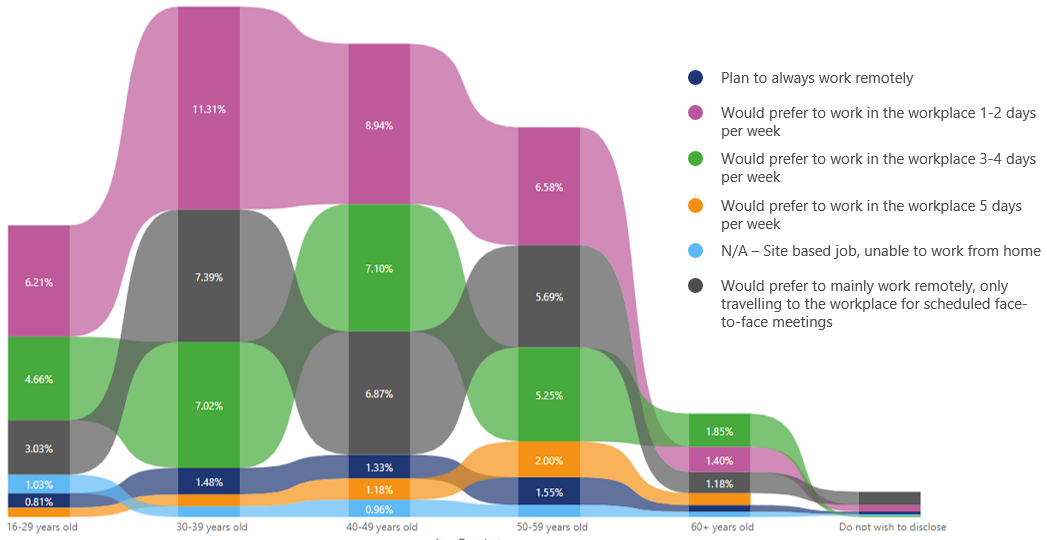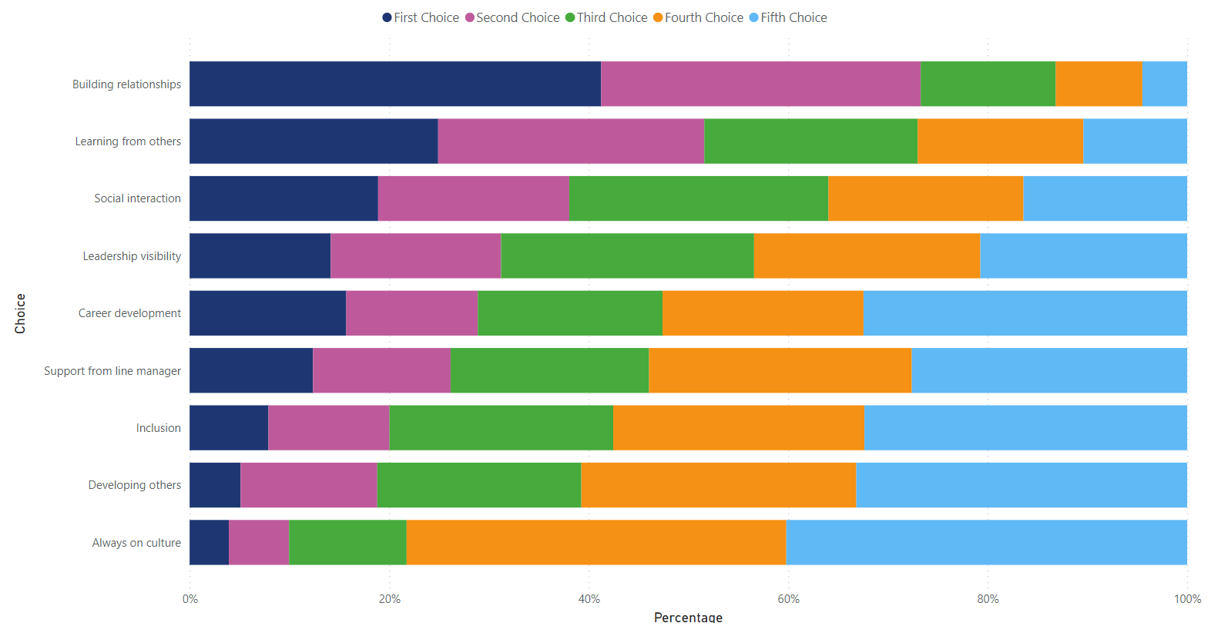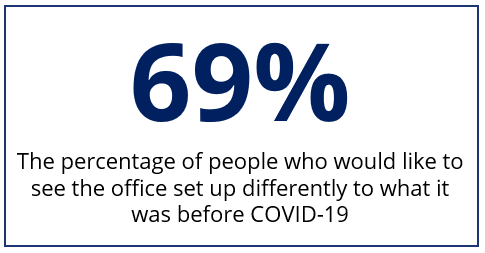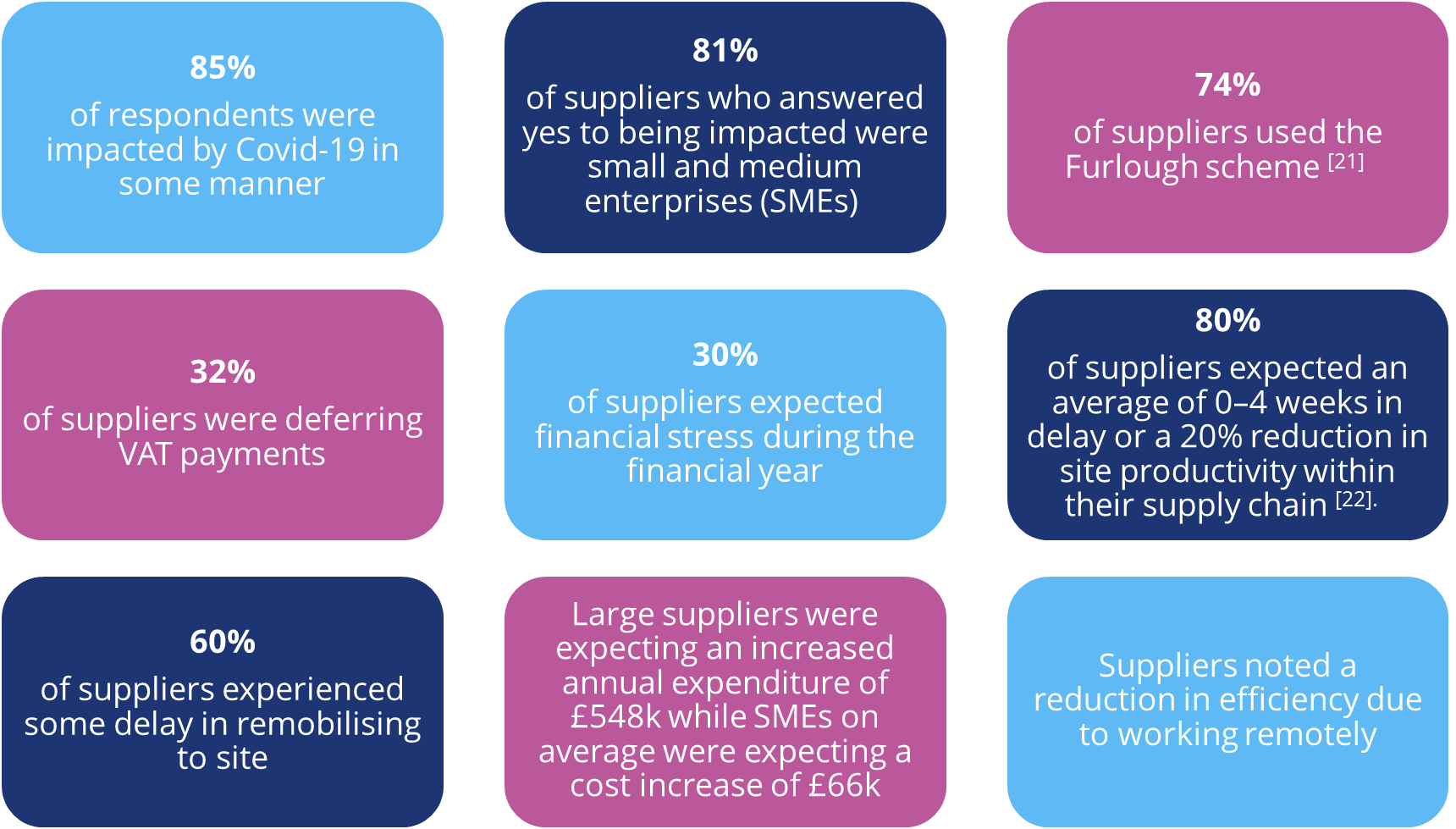HS2 back to better programme-Building organisational resilience post COVID-19
HS2 Ltd and its delivery partners in the supply chain established the Back to Better Programme to implement consistent and effective control measures for work sites in line with its seven Safe at Heart focus areas to mitigate the impacts of COVID-19. This would provide clarity, information and guidance to the supply chain to allow it to navigate its way through the pandemic and consider potential measures to mitigate the impacts of a future pandemic. HS2 Ltd and its delivery partners in supply chain worked collaboratively in response to the changing COVID-19 guidance to support their office and community-based employees.
Findings from the Back to Better Programme highlight how HS2 and its supply chain reacted to the challenge to delivery posed by the pandemic through its ability to adapt, implement change rapidly, and maintain construction momentum.
This paper discusses the adopted practices arising from the pandemic that organisations can consider as long-term opportunities to improve health, safety and wellbeing and improve efficiency of projects across the construction/infrastructure industry.
The overarching opportunity for organisations for the future, based on our experiences of responding to the challenges of the pandemic, is the importance of investing time and resource into planning and instilling future resilience. Further to this, organisations should create and maintain an inherent culture of challenging the norm and continually look for opportunities to improve the levels of safety and efficiency across their projects.
Background and industry context
The COVID-19 outbreak in early 2020 [1] had a massive impact on the construction industry and UK society.[2] Our traditional ways of living and working were halted almost overnight. HS2 was not isolated from the impacts. Staff were told to stay at home, including 1,300 direct HS2 Ltd employees, and worksites were shut down. This had huge implications for the momentum of the HS2 project. However, HS2 and its supply chain partners responded to the challenges posed by COVID to get worksites operational within government restrictions and HS2’s Safe at Heart[3] approach, to allow the project to continue its progress.
Approach
From May 2020 to June 2022, the HS2 Back to Better Programme worked together to mitigate the impact of the pandemic on the HS2 project, whilst identifying examples of best practice and innovation to be carried forward in a post-pandemic world, in order to improve the way in which the construction and infrastructure sector operates.
This paper highlights the mitigations implemented over those two years, examples of guidance notes produced for working under government restrictions and areas of transformation that the Back to Better Programme identified that could be applied to improve delivery and resilience. This paper sets out conclusions and opportunities to promote continuous improvement.
The coronavirus pandemic was unprecedented for not only the HS2 project and its people, but also the entire UK society and economy, leading to rapid changes to be able to maintain construction momentum. In March 2020, the point at which the COVID-19 outbreak was officially recognised as a pandemic, there were roughly 20,000 people working on HS2, so it was imperative that the project found ways to overcome the challenges presented.
The Back to Better Programme’s findings highlight how the construction and infrastructure sector found the ability to adapt, implement change rapidly and maintain construction momentum. Furthermore, the adopted practices arising from the pandemic should be considered as long-term opportunities to improve resilience, health and safety and improve efficiency of projects across the industry.
COVID-19 Guidance Notes
The HS2 Back to Better Programme, in conjunction with its delivery partners in the supply chain, produced a series of guidance notes through the various stages of the pandemic in response to changes in the government’s lockdown rules supported by HS2’s Safe at Heart principles.
These guidance notes were updated based on best practice, guiding principles, and behaviours that built upon previous guidance and were issued alongside the latest Construction Leadership Council guidance and Site Operating Procedures[4].
The Back to Better Programme guidance notes covered the following topics:
- COVID-19 Second Wave (October 2020)
- COVID-19 Alert Level 5 (January 2021)
- Face Coverings (March 2021)
- Supplementary Testing when Travelling from Abroad (May 2021)
- Time Management (August 2021)
Areas of Transformation
The Back to Better Programme identified four key areas to explore to see how lessons from responding to the pandemic could be adopted for the longer-term benefit of the construction industry. These were recognised as ‘Areas of Transformation’ and covered:
- hybrid working
- future office
- reducing time on site
- improving supplier engagement
The Areas of Transformation highlight opportunities for organisations to improve their resilience to be able ‘to thrive, not survive’ in the face of future challenges. The Areas of Transformation looked across four areas of the HS2 project reviewing ways of working which, pre-COVID, may have been considered ‘traditional’.
Outcomes
Back to Better Programme Survey Results
In May 2021, the Back to Better Group completed a survey capturing the thoughts of 1,389 people working in HS2 Integrated Project Teams at the time. This included some HS2 Ltd and tier one supply chain staff. Extracts of the survey’s findings are set out below in relation to the four Areas of Transformation.
Hybrid Working
One of the key findings from the May 2021 survey, was the importance of organisations implementing and retaining hybrid working as ‘business as usual’. As of May 2021, 87% of respondents said that they were working flexibly and wanted to continue doing so post-pandemic.
Future Office
The survey found the majority of respondents thought that building relationships was the most important benefit of the office, with learning from others the second most important. Further to this, 16 to 29-year-olds said that learning from others was the primary benefit of working in an office.
Reducing Time on Site
Reducing time on site looked at ways projects could reduce the need for staff to be on site, through the use of off-site manufacture, reduced people/plant interfaces, virtual meetings, the use of technology, such as drones and cameras for assurance, off-site inductions, working day rehearsals and training.
The survey asked whether having access to equipment such as CCTV cameras, aerial footage, a booking system for virtual inspections, or virtual tours through drones would reduce the need for them to be on site. Over a quarter of people said that this would ‘somewhat’ reduce the need for them to be on site.
Improving Supplier Engagement
Reviewing the approach to supplier engagement looked at the way in which the supply chain working with HS2 operated throughout the pandemic, how well they reacted, working practices and improving communications.
Building Resilience
The survey found the majority of respondents, 59%, had not seen or taken part in potential future ‘significant event’ scenario training with HS2 or their Integrated Project Team/Joint Venture since the start of the pandemic., Over a quarter (27%) said that they did not think they had taken part in scenario training. 6% said that they had been involved once and 5% said that they had been involved multiple times.
This highlighted an issue and a potential threat to future resilience, as the survey results showed that the majority of those surveyed were potentially not aware or prepared for the measures and actions to take, should another unplanned disruptive event occur.
Learnings and Identified Opportunities
Areas of Transformation Findings
Hybrid Working
Hybrid working supports bringing an organisation’s people, processes, connectivity and time together, to facilitate the most appropriate and effective way of working to carry out a particular activity. This became more important during the pandemic (see Figure 1).

What did hybrid working look like at HS2 Ltd and within the Tier One Supply Chain?
At the start of the pandemic there was no specific HS2 Ltd guidance document for hybrid working, although the organisation redeveloped its Flexible Working Policy[5] as a result of the pandemic. The policy set out key principles and procedures behind flexible working, as well as an eligibility criterion for employees. HS2 Ltd’s policy regarding flexible working began in response to many restrictions being lifted by the Government in October 2021, where the organisation decided to encourage office attendance of three days per fortnight, increasing to five days per fortnight in November 2021. Restrictions put in place by the UK Government in late December 2021, meant that the majority of people returned to working from home full time, although HS2 Ltd’s offices remained open for those that were unable to do so. In late January 2022, these additional measures were removed by the Government, resulting in HS2 Ltd returning to the recommendation of five days of office attendance per fortnight at the start of February 2022.
HS2 Ltd provided guidance to its employees based on the ‘Three-Ps’ – personal choice, professional capacity and programme – to maximise productivity. This built upon HS2 Ltd’s engagement throughout the pandemic with its Workplace Forum and the Transport Salaried Staffs’ Association (TSSA), HS2 Ltd’s officially recognised trade union, to successfully overcome the challenges of operating during COVID-19. Following the pandemic, HS2 Ltd now has a permanent Hybrid Working Policy[6] for all its staff.
During the two years of the Back to Better Programme, the Tier One Joint Venture organisations, those that had the direct contract with HS2 Ltd, working with HS2 adapted their approach to hybrid working, mostly in accordance with COVID-19 statistics and Government guidance. HS2’s partners implemented their own guidance on a periodic basis (aligned with Government guidance changes), from July 2021. The approaches varied with some JVs offering a fully flexible approach, with others mandating between two and four days in the office.
Findings of industry reports and pilot studies
There have been multiple reports and studies produced and conducted throughout the construction industry as a result of the pandemic. One of these was produced by Timewise in partnership with construction companies BAM, Skanska and Wilmott Dixon.
Timewise helped these firms to implement flexible working pilot schemes among a collective 12,000 workers, the majority of which were based on the frontline. These pilot schemes ran between June 2020 and February 2021, through the pandemic. The size of teams ranged from 14 to 120 workers.
Some of the recommendations from the report for construction firms are: ‘determine a clear vision which starts at the top’, ‘consider options for flexibility in every role’, and ‘measure the return on investment of flexible working in terms of project performance and productivity’[7].
Hybrid working opportunities to explore
It was important that HS2 Ltd and the project’s supply chain recognised the significant changes in working practice that occurred as a result of the pandemic. Society as a whole, not just the industry, saw a massive shift in what was seen to be acceptable and practical for workers with regards to working location, hours and much more. It is important that this shift is reflected in policies, helping to address existing concerns and stigmas within the construction industry and to make the most of the project’s high-profile platform to drive change. The responses to Back to Better group’s May 2021 survey showed a clear preference for flexibility towards working location. Shown below in Figure 2.

Figure 2: Ribbon chart to show working preference by age bracket.
As a result, this paper highlights the following opportunities for organisations to consider to help them adapt to hybrid working:
- Setting a clear, relatable and understandable vision of what hybrid working looks like now and in the future, for everybody involved in an organisation/project.
- Establishing an accessible platform for employees to give feedback on hybrid working and hold regular sessions with a diverse panel of employees to discuss.
- Establishing a working group to create and drive change by regularly reviewing, sharing and promoting organisational policies, along with their benefits.
- Regularly reviewing and where relevant, implementing, recommendations from industry wide reports, such as the Timewise Report[8].
Future Office
The move to hybrid working offers the question of what offices might look like in the future. A mix of working in the office and from home offers the potential for a new, exciting way of working and a shift from the traditional workplace.
A 2021 paper in the “Harvard Business Review” stated that: “Pre-pandemic, most businesses saw the office as a place where individuals could get work done. Post-pandemic, the office will only secondarily be a place to carry out tasks or engage in routine meetings, especially for knowledge workers” [9]. This is supported by responses to Back to Better group’s May 2021 survey, demonstrated in Figure 3.

The challenge for organisations going forward is to encourage employees to reconnect with the office. To support this, the office – the physical and cultural environment – needs to be a destination.
Throughout the pandemic and since, some employees have thrived from a better work/life balance. Technology has enabled effective working from home through emails, video calls and virtual meetings. However, this does not replace the fundamental benefits of face-to-face working. The office creates a communal environment for colleagues and teams to come together to discuss issues, explore new ideas and respond to common challenges.
Post-pandemic, organisations should recognise that being together in the office – not necessarily full-time – is vital to build on key values, innovate, grow and share knowledge for future success. To do this, organisations need to make the office a place where people want to be, not somewhere they have to be.
What does Future Office look like at HS2 Ltd?
The HS2 Ltd Facilities Team has trialled what offices might look like in the future. The way the organisation uses its workspace may change with the traditional set up of rows of desks evolving into spaces which, while including desks, can accommodate a variety of innovative work settings; whether that be collaboration areas, a quiet space to take calls, or breakout zones for informal conversations with colleagues.
The aim should be to create the kind of working environment that will inspire and excite colleagues to do their best work.
What does Future Office look like within the wider industry and at other organisations?
Whilst we cannot predict the future, many believe it is likely to involve increased hybrid working – a mix of working in the office and working at home. The Harvard Business Review discusses the value of a “hybrid office” that is “between a home work space and a traditional office building”. The overarching benefit of the office space will be to provide colleagues with “a social anchor, facilitating connections, enabling learning, and fostering unscripted, innovative collaboration” [10].
In a 2021 report, asset management firm UBS, argued that the internal layout of offices will need to take on “a new focus, to reflect the primary reason for being in the office on any given day: interaction”. Their report states that there will be a “fundamental shift away from the provision of functional workstations, and a clear focus on meeting rooms and breakout areas”. However, they recognise “the requirement for desk space will remain, but the balance between the two will shift significantly” [11].
Future office opportunities to explore
It is clear that there are many options and approaches to what offices should look like post-COVID-19. The Back to Better group’s May 2021 survey result (see figure 4) also found that they would like a change in their office setup.

What is certain is that change should be driven by what culture an organisation wants to maintain within its workforce. Therefore, a distinct set of recommendations are hard to agree on. Instead, there are a range of options for organisations to explore to meet their needs. Office design and utilisation of new technology will support delivering this outcome. For example:
- Designing offices to support specific organisational priorities.
- Balance the demand for desks with increased multi-purposed activity-based working
- Create workspaces specifically designed to support the kinds of interactions that cannot happen remotely.
- Use hybrid spaces for breakouts and safe, creative areas for essential collaboration.
- Contactless technology to allow seamless access into and around the workplace.
- Gesture technology (sensors to interpret hand movements) can be implemented in regularly used, high risk areas such as doorways, lifts, and welfare facilities.
- Online visitor management systems can adopt contactless technology for tracking location while visiting sites.
Reducing Time on Site
Following the onset of COVID-19, construction sites faced unprecedented health and safety challenges. Employers had to react and establish control measures in order that employees could return safely and allow construction to continue. The HS2 project was no different and used its seven Safe at Heart[12] focus areas to help guide its mitigations.
Government regulations made it an offence for certain premises and businesses to operate, for people to leave their homes without reasonable excuse and for there to be gatherings in public places of more than two people. While Public Health England (PHE) guidance in March 2020 acknowledged that while all employees should be encouraged to work from home unless it was impossible for them to do so, certain jobs require people to travel and the guidance expressly referenced those who work in construction. The combination of this contrasting guidance resulted in construction sites balancing the ability of getting essential teams back to work with increased safety measures in line with PHE (now UK Health Security Agency) [13], Health and Safety Executive (HSE) [14], and Construction Leadership Council (CLC) [15] guidance.
One of the main recommendations was to only have essential workers on site and to work remotely where possible. This guidance had the impact in reducing the number of people, and the amount of time, spent on site. As a result of these challenges, there was a greater awareness of advances in technology and improved ways of working. These could be capitalised going forward to combine advances in technology with a reduction of the number of workers required on site, or the amount of time they spend on a site, therefore reducing construction health risks and reducing costs, provided high safety standards were maintained.
What does reducing time on site look like at HS2 Ltd and within the Tier One Supply Chain?
One of the key aims of HS2’s Innovation Strategy [16] is “Improving Productivity: Reducing Time and Cost” through “enhancing the use of resources in the design and build of HS2” and “employing new technologies and techniques to reduce time and cost”.
This challenge grew during the pandemic but there is the opportunity to build on innovations that were put in place during this time when employees were not able to attend site as they would have wished to. Reducing time on site will mean different things to individuals depending on their disciplines but will include looking at ways in which the project can reduce the need for staff to be on site, through the use of off-site manufacture, reducing people/plant interfaces, more virtual meetings, and greater use of technology, such as drones and cameras for assurance. It is also in line with HS2’s Safe at Heart strategy: I care. You count. We matter [17].
As part of enhancing virtual accessibility to construction site information, HS2 Ltd created a Virtual Construction Operations Room (VCOR). This is a digital platform which encompasses integrated data, across the entirety of HS2 Main Works Civils in Phase One. VCOR includes data on construction, community engagement, environment, security and resilience and land and property. By bringing together so many sets of data, it is much easier and more efficient to remotely find, interpret and use data effectively.
Looking to the future, HS2 Ltd is working on reducing time on site in relation to the operational railway. The current designs and data for the railway network will both inform construction of HS2 and build the railway’s digital twin, a virtual reality 3D replica that will be as detailed as the constructed railway.
During HS2’s construction thousands of remote condition monitoring sensors, similar to those used in Formula One and aviation, will be built into the physical line’s infrastructure as if it were the railway’s version of the body’s nervous system. These sensors will monitor performance of the railway’s assets and components to predict and prevent failure, helping to underpin the line’s reliability and ultimately the punctuality of its passenger services.
Reducing time on site opportunities to explore
There are synergies with the hybrid working and future office themes above that can be seen with innovations to reduce time on site. The challenges of working on site posed by the pandemic have created advantages and disadvantages not previously considered. For example, hosting virtual site tours to engage external visitors has reduced the impact of frequent site visits which can impair construction progress. Site visits remain a critical and important part of stakeholder engagement for construction projects, however there is also the opportunity to provide excellent insight through virtual tours.
There is now a great opportunity to embed some of the remote, virtual working practices that have been introduced for the long-term to improve safety, create cost savings, improve productivity and enhance engagement. There will be a need to upskill workforces to maximise best use of the technology going forwards.
Options for organisations to consider are:
- Embracing the use of remote technology and data, investing in collection and storage, as well as management, in order for it to be available as a reporting/analytics tool.
- Promoting innovation platform for colleagues to provide feedback on opportunities and examples of initiatives to reduce time on site or making working practices safer and more efficient.
- Holding regular sessions with a diverse panel of employees to discuss their experiences of working on site and how practices could be improved.
- Establishing an industry-led working group to drive change by regularly reviewing, sharing, and promoting innovation along with their benefits.
Improving Supplier Engagement
Improving supplier engagement looked at the way in which HS2’s supply chain worked throughout the pandemic, how well they reacted, working practices, improvement in communications, and much more.
HS2’s contractors engaged and worked with procurement platform Constructionline[18] to analyse the impact on the wider construction supply chain, to understand their responses to the pandemic and to help inform contractors’ medium/long-term mitigation action plan. The survey data set covered:
- Financial stress
- Suspended operations
- Utilisation of Government assistance
- COVID-19 operating procedures
- Impacts on supplier costs and productivity.
In addition to the survey undertaken by Constructionline, HS2’s contractors engaged with their wider supply chain through other procurement platforms such as CompeteFor [19] and Market Dojo [20] to understand the impact of the pandemic on their operations and how that may affect their ability to fulfil HS2 contracts.
Risks to the Supply Chain as a result of the COVID-19 pandemic
As with most industries, HS2’s supply chain faced a difficult situation during the pandemic mainly regarding interruption to work and on-going uncertainty. Constructionline undertook a survey at the end of 2020 amongst their members to understand how the COVID-19 situation was affecting them. This survey could then be used to identify the mitigations that could be put in place to help the contractors.
Approximately 8,000 Constructionline members responded to the 2020 survey which provided a good initial insight on the impact the pandemic had on its members’ staff and businesses. The highlights (Figure 5) from this survey included:

What does improving supplier engagement look like at HS2 Ltd and within the Tier One Supply Chain?
HS2’s contractors set up the ‘Supply Chain Collaboration Hub’ working group through which a consistent approach was agreed and implemented. Providing technology support to the supply chain played a vital role in reducing the impact to the contractors’ operations and productivity. Communication tools such as Microsoft Teams was made accessible and shared with the supply chain and external partners which enabled collaborative working through a remote environment.
MoSCoW [21] analysis (developed by Dai Clegg while at Oracle, to summarise a project’s priorities: Must, Should, Could and Won’t) was undertaken by all HS2 contracts to identify when activities would be safe to continue based on their assessed risk profile. This allowed the contractors and supply chain to focus the limited available resource on these activities that were safety and business critical to the HS2 programme.
HS2 and its contractors were well aware of the difficult time for the supply chain and were acutely aware of the impact this was having on business continuity, particularly for small and medium enterprises. Therefore, there was a commitment to continue to pay invoices within terms and not intentionally delay payment to manage individual organisation’s own cash position.
From the survey undertaken by the Back to Better Programme, over 50% of the respondents believed that the supply chain had consistently adapted to changes in working practices since the pandemic. Overall, this highlights the good work of the supply chain throughout the pandemic.
These statistics, show that there is a general consensus that the HS2 supply chain managed their activity throughout the pandemic well, adapting to changes in working practices, supporting employees in flexible working, and improving their operation.
Supplier engagement opportunities to explore
It is clear that engaging with suppliers and the wider supply chain has had a profound and mutual benefit and can support more effective project delivery. Organisations should look to embed longer term relationships with their supply chain as a result. At all supply chain levels of a project there are potential activities to support this objective including:
Contractors’ Procurement Teams could:
- Use Constructionline to identify risk with given trades to support with package strategies
- Account for the average increased lead time of four weeks for suppliers to purchase materials or services
Contactors’ Operations Teams could:
- Provide more support and/or guidance around remote working practices for suppliers working remotely to increase efficiency
- Enhance communication and guidance for site operational procedures to suppliers
Client Organisations could:
- Encourage suppliers to diversify their own supply chain to mitigate risk
- Share procurement pipelines to provide visibility of required resources from the supply chain to tender
- Consider financial support for suppliers such as advanced payments
Conclusions
From the early stages of the pandemic and the production of guidance notes, to the review of the Areas of Transformation, the HS2 Back to Better Programme recognised the importance of producing outputs that were forward looking and would provide direction and information for developing business resilience. Consequently, the Back to Better Group decided that the four Areas of Transformation ultimately fed into the wider challenge of Future Business Resilience.
The Back to Better group May 2021 survey aimed to understand the perception of how well the HS2 project as a whole, as well as respondents’ parent companies adapted and responded to business disruption due to the pandemic, as well as how well they are prepared to handle any significant future events. Overall results are shown below in Figure 6.

Therefore, the overarching conclusion and key point for organisations to consider, based on HS2’s experiences of responding to the COVID-19 pandemic, is the importance of investing time and resource into planning and instilling future resilience. Further to this, organisations should consider creating and maintaining an inherent culture of challenging the norm, and continually looking for opportunities to improve the levels of safety and efficiency across their projects.
Further, related improvement opportunities include:
- Setting a clear, relatable and understandable organisation vision of what hybrid working looks like now and in the future, for everybody involved with the project.
- Creating workspaces specifically designed to support the interactions that cannot happen remotely
- Embedding remote, virtual working practices that have been recently introduced for the long-term to create cost savings, improve health and safety and productivity, and enhance engagement
- Identifying risks within supply chains to support with package strategies and providing guidance around remote working practices for suppliers to increase efficiency
Responding to the pandemic through sharing lessons learned and best practice has shown that organisations need to collaborate more openly across their projects and their supply chains in the future to successfully build and maintain greater resilience.
While these are the findings and conclusions, of the HS2 Back to Better Programme, they should be reviewed alongside an organisation’s own current resilience measures and their lessons learned from their response to the pandemic. This should facilitate productive discussions and thinking to challenge the norm and create changes for a more resilient future for the industry.
Building Business Resilience
Despite the pandemic ending, its impact can still be felt. Creating new ways of working and planning for the future can allow organisations to build resilience and innovate and advance even in tougher times.
Creating business resilience will enable organisations to adapt and respond to future unforeseen disruptions or changes, whilst protecting their staff, and maintaining their core operations. Aviva, in association with the Centre for Economic Business Research, highlighted key factors for a resilient business. Key themes are summarised below in Table 1, along with how they relate to the Areas of Transformation set out above.
Table 1 – Business Resilience Factors
| Key factors for a resilient business | Summary | Area of transformation |
|---|---|---|
| Workforce resilience | Employees are an organisation’s most important asset. It is important to plan for any future challenges by identifying potential skills gaps, resource restrictions, as well as carefully monitoring levels of employee engagement. | Hybrid working Future Office |
| Operational resilience | COVID-19 showed the need to implement risk-management procedures and contingency planning to protect against unexpected events. This can include precautions against the effects of extreme weather and other physical risks, cyber-attacks or potential data breaches and less obvious risks, such as future regulatory change. If an organisation is reliant upon suppliers, it should always consider the ‘knock-on effect’ which might result from those suppliers’ own exposure to these risks | Hybrid working Reducing Time on Site |
| Commercial resilience | A commercially resilient organisation makes good use of insights on how to retain and grow its existing supply chain. It is also important to adopt a business strategy which recognises the need to avoid dependence on only a small number of businesses. | Supply Chain Engagement |
| Financial resilience | Maintaining financial resilience to manage potential change concerns, the assets of an organisation, the reliability of its cashflow, and how easily it can access finance in times of need or opportunity. | Hybrid working Future Office Supply Chain engagement |
| Future resilience | Creating resilience prepares an organisation to remain competitive in the future – taking into account societal and economic change, technological advance, and product development. Indicators of a future resilient business include prioritisation of product innovation and thought leadership, strategic flexibility and maintaining a clear long-term business vision [24]. | All |
Business Resilience during COVID-19 – the wider industry
During the COVID-19 pandemic, many organisations stepped up to the challenge, adapting their businesses and strategies to overcome challenges and achieve opportunities.
The disruption caused by the pandemic has led to a rapid acceleration of trends that were present before the crisis. A McKinsey study found that the best performing companies, with “future-ready business models” [25] were a step ahead in the transition to a post pandemic new operating norm.
As part of its series about COVID-19 enterprise resilience, EY made seven recommendations in relation to overarching plans to build resilience. They recommend organisations implement a “business continuity plan… as well as an evolving resilience strategy” [26].
As society moves out of the pandemic, organisations must continue to improve the way they operate, how their staff work and how they engage with their supply chain to ensure they are better prepared to deal with another event that causes the scale of disruption the pandemic did. This will help organisations build their resilience and face up to new challenges in a proactive rather than solely reactive manner. Time, money and collaboration invested now is critical to supporting this.
By reviewing the issues and recommendations raised in this report and implementing measures to increase resilience, organisations will be better placed to respond to the challenges of future disruptive circumstances on the scale of the covid pandemic.
Acknowledgements
HS2 Back to Better Team:
David Emms, Project Client Director, HS2 Ltd
Daniel Twort, Senior Project Manager, HS2 Ltd
Sam Arrowsmith, Project Manager, HS2 Ltd
Andreas Michael, Project Manager, HS2 Ltd
Jennifer Lennon, Senior Project Manager, HS2 Ltd
Arlo Dew, Senior Project Manager, HS2 Ltd
HS2 Project Joint Ventures (JV):
Balfour Beatty and Vinci (BBV) JV
Eiffage, Kier, Ferrovial Construction and Bam Nuttall (EKFB) JV
Bouygues Travaux Publics, Sir Robert McAlpine, and VolkerFitzpatrick (Align) JV
Skansa, Costain and Strabag (SCS) JV
Laing O’Rourke and J. Murphy & Sons Ltd (LM) JV
Morgan Sindall Infrastructure, BAM Nuttall and Ferrovial Agroman (Fusion) JV
Costain and Skansa (CS) JV
Mace and Dragados (MD) JV
Balfour Beatty, Vinci and Systra (BBVS) JV
References
1. Institute of Government, Dec 2021, “Timeline of UK Government coronavirus lockdowns and measures, March 2020 to December 2021”. Accessed 10 July 2023
2. John Allcoat, 19 October 2021 “How has UK construction performed over the pandemic?” Office for National Statistics, National Statistical. Accessed 10 July 2023
3. HS2 Safe at heart, 2023 . Accessed 10 July 2023
4. Construction Leadership Council, Site Operating Procedures Version 9.1, 2023 . Accessed 10 July 2023.
5. HS2 Ltd, Flexible Working Policy (HS2-HS2-HR-POL-000-000044), Jan 2023.
6. HS2 Ltd, Hybrid Working Policy (HS2-HS2-HR-POL-000-000095), Feb 2023.
7. Timewise, 2021, “Making Construction a Great Place To Work: Can Flexible Working Help?” . Accessed 10 July 2023
8. As 7 above
9. Fayard, Weeks & Khan, 2021 “Designing the Hybrid Office: From Workplace to “Culture Space”, Harvard Business Review. Accessed 10 July 2023
10. As 9 above
11. Embracing change: The future of the office sector post-COVID-19, UBS, Herm & Guage, 2021
12. HS2 Ltd Safe at Heart: Our seven risk focus areas, May 2023. Accessed 10 July 2023
13. Gov.uk UK Health Security Agency . Accessed 10 July 2023
14. Health & Safety Executive, Nov 2022, “Coronavirus (COVID-19) – Advice for workplaces”. Accessed 10 July 2023
15. As 4 above
16. HS2 Ltd Jun 2023 Innovation . Accessed 10 July 2023
17. HS2 Learning Legacy Oct 2021, “Building and sustaining a health and safety brand that connects everyone to being Safe at heart” .Accessed 10 July 2023
18. Constructionline .Accessed 10 July 2023
19. CompeteFor .Accessed 10 July 2023
20. Marketdojo .Accessed 10 July 2023
21. MoSCoW prioritisation method
22. Gov.uk website, “Check if you can claim for your employees’ wages through the Coronavirus Job Retention Scheme” . Accessed 10 July 2023
23. Constructionline, 2020 The impact of COVID-19 across the Construction Industry, “UPDATED [Infographic] in collaboration with Build UK . Accessed 10 July 2023
24. Aviva 2000, “UK Business Resilience: The State of the Nation” .Accessed July 2023
25. McKinsey, Diedrich, Northcote, Röder & Sauer-Sidor, March 2021 “Strategic Resilience During the COVID-19 Crisis” .Accessed 10 July 2023
26. EY, COVID-19 enterprise resilience June 2020 “How to Strengthen Business Resilience During Disruptive Events” .Accessed 10 July 2023
Supporting Materials
- Back to Better Survey Findings/Report
- Back to Better guidance notes (5no.)


